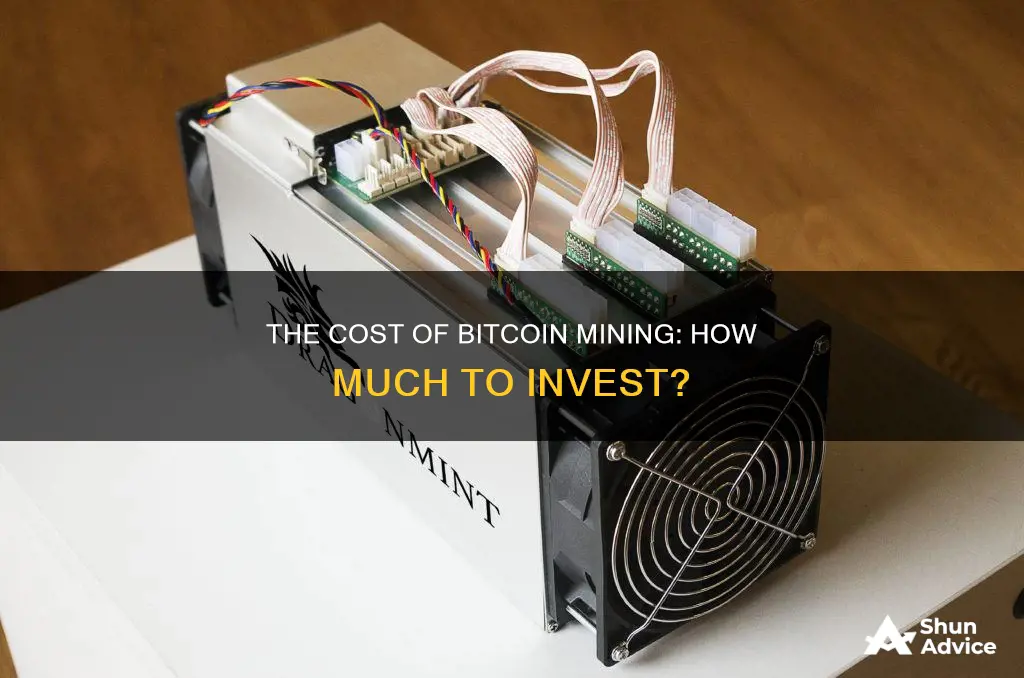
Bitcoin mining is the process of validating Bitcoin transactions and minting new coins. It is a network-wide competition to generate a cryptographic solution that matches specific criteria. When a correct solution is reached, a reward in the form of bitcoin and fees for the work done is given to the miner(s) who reached the solution first.
To successfully mine bitcoin, you need to invest in a powerful system with the latest and fastest CPU, GPU, storage, and cooling. You can also join a mining pool, which is a group of crypto miners who pool their resources and share rewards. The cost of investing in bitcoin mining can range from a few hundred dollars to thousands, depending on the type of system and equipment you choose. Additionally, you need to consider the price of electricity, as bitcoin mining can consume a significant amount of energy.
Overall, while it is possible to make money from bitcoin mining, it is important to carefully consider the costs and potential profits before investing.
What You'll Learn

Bitcoin mining hardware
ASIC miners are designed for mining a specific cryptocurrency and are the most powerful option for Bitcoin mining. These machines are expensive, but they are also the only type of device where you can potentially make a profit from Bitcoin mining. The cost of an ASIC miner can range from about $1,000 to more than $15,000, with the most profitable and best ASIC Bitcoin miners usually being the most expensive.
When choosing an ASIC miner, there are several factors to consider, including the hash rate, power consumption, and noise level. The hash rate refers to the number of hashes the machine can generate per second, and the higher the hash rate, the more Bitcoin you can mine. However, a higher hash rate usually means higher power consumption, which can impact your profitability, especially if you live in an area with high electricity costs. Additionally, some machines with high hash rates, such as the Antminer S19 XP Hyd, can be very noisy, which may be off-putting for some investors.
Another option for Bitcoin mining hardware is GPU mining, which uses one or more graphics cards. This method can be costly upfront, as you need to purchase the graphics cards, and it may not be as effective as ASIC mining for Bitcoin due to the lower power. CPU mining, which uses a computer's central processing unit, is also an option, but it is no longer recommended for Bitcoin mining due to the lack of competitive processing power compared to ASICs.
Before investing in Bitcoin mining hardware, it is important to consider the high costs, competition, and environmental concerns associated with the activity. Bitcoin mining is very competitive, and the difficulty level increases as more miners join the network. Additionally, the high energy consumption of Bitcoin mining has drawn criticism from environmental groups, and the activity may not be profitable for individuals due to the significant upfront costs and ongoing electricity expenses.
Bitcoin: The Original and Best Investment Option
You may want to see also

Electricity costs
Bitcoin mining is an energy-intensive process. It requires a lot of electricity to power the computers that solve complex equations to verify transactions in the currency. The amount of electricity consumed by Bitcoin mining has drawn criticism from environmental groups and poses a challenge to the profitability of miners.
The cost of electricity varies from country to country and region to region, and so does the cost of mining Bitcoin. In March 2022, the average cost to mine one Bitcoin across 198 countries was $35,404.03, which was more than the value of Bitcoin at the time. However, in some countries, the cost of mining one Bitcoin was far higher, such as in Venezuela, where it cost $246,530.74, and the Solomon Islands, where it was $80,189. On the other hand, in countries like Kuwait, it is much cheaper, at $1,393.95.
The electricity consumed per Bitcoin transaction is estimated to be 781 kWh, according to the Bitcoin Energy Consumption Index. This means that mining a single Bitcoin could use the same amount of electricity as half a million PlayStation 3 devices or the amount of electricity consumed by an average U.S. household in 13 years.
The high electricity consumption of Bitcoin mining has led to concerns about its environmental impact and carbon footprint. The energy required by the network is vast, and some estimates claim it equals the energy used by smaller countries. The increase in electricity consumption for Bitcoin mining has also resulted in higher mining costs for miners, especially with the rise in electricity rates.
To reduce costs and increase their chances of profitability, Bitcoin miners can join mining pools, which allow them to share resources and add more capability. However, shared resources also mean shared rewards, so the potential payout is lower when working through a pool.
Strategic Bitcoin Investments: Growing Your Money
You may want to see also

Bitcoin mining pools
There are several types of mining pools, each with its own pros and cons. Here are some of the most common types:
- Application-Specific Integrated Circuit (ASIC) Mining Pools: These pools use specialised devices built for the sole purpose of mining a specific cryptocurrency. ASICs are the most powerful option for Bitcoin mining and offer the highest potential for profits. However, they can be costly, with new ASICs ranging from $1,000 to over $15,000.
- Graphics Processing Unit (GPU) Mining Pools: GPU mining uses one or more graphics cards to mine crypto. While this method is popular for mining other types of cryptocurrencies, it may not be as effective for Bitcoin due to the lower power compared to ASICs.
- Central Processing Unit (CPU) Mining Pools: CPU mining uses a computer's central processing unit, making it the most accessible way to mine crypto. However, CPUs lack the processing power to compete with ASICs, so it is no longer recommended for Bitcoin mining.
- Cloud Mining Pools: Cloud mining involves renting a mining device from a company and receiving the profits after maintenance and electricity costs are deducted. This option may not be ideal if cryptocurrency prices fall, as it can be difficult to break even.
- Peer-to-Peer Mining Pools: These pools aim to prevent centralisation by integrating a separate blockchain related to the pool itself. They are designed to prevent cheating by pool operators and ensure the pool's stability.
When choosing a mining pool, it is important to consider factors such as the pool's size, speed, payout scheme, and transparency. While larger and faster pools may offer higher rewards, there may be a point where the pool becomes too large to benefit individual miners. Additionally, it is crucial to understand the pool's payout scheme, as different schemes have varying payout calculations.
Strategic Bitcoin Investment: A Guide for Businesses
You may want to see also

Bitcoin mining software
There are several types of mining software available, each with its own unique features and benefits. Here are some of the most popular options:
CGMiner
CGMiner is one of the oldest bitcoin mining software programs, dating back to 2011. It offers a flexible platform that supports the mining of various cryptocurrencies, including Dogecoin and Litecoin. CGMiner works with a range of hardware options, including ASICs, FPGAs, and GPUs. It runs on a command-line interface, which can be challenging for beginners, but it provides remote management capabilities for mining rigs.
Awesome Miner
Awesome Miner is ideal for those who want to manage multiple mining rigs and pools in one place. It offers a centralised dashboard to track mining performance, including metrics like hash rate, fan speeds, device temperature, and earnings. Awesome Miner supports Windows and Linux and also offers a cloud-based web version accessible via a browser.
EasyMiner
EasyMiner is a user-friendly platform that automatically starts mining cryptocurrency upon setup. It is designed for less powerful CPU and GPU mining capabilities. EasyMiner provides a dashboard with graphical representations of mining workflows, making it simple to switch mining pools and check crypto wallets. It also supports mining for cryptocurrencies other than Bitcoin, such as Litecoin.
Kryptex Miner
Kryptex Miner is a Windows app that pays users for their computer power. It automatically switches to mining the most profitable cryptocurrency based on market conditions. Users with gaming PCs can expect earnings of around $95 per month, while more powerful mining rigs can yield higher payouts. Kryptex Miner offers a "lite mode" that allows users to use their computers for other activities simultaneously.
ECOS
ECOS is a cloud-based mining platform that does not require users to purchase specialised mining equipment. Instead, users pay upfront for a mining contract, leasing bitcoin mining equipment and electricity. Users can forecast the price of bitcoin, contract duration, and desired hash power. While profit margins may be lower compared to owning equipment, ECOS provides a convenient and straightforward mining solution.
Cudo Miner
Cudo Miner is a cryptocurrency mining software that helps users maximise their profits by automating their mining rigs. It supports GPU, CPU, and ASIC hardware and is suitable for miners of all experience levels. Cudo Miner offers advanced features such as auto-switching, auto-tuning, monitoring, and remote management. It also includes a machine learning component to fine-tune mining for maximum returns.
A Teen's Guide to Investing in Bitcoin
You may want to see also

Bitcoin mining profitability
Firstly, mining Bitcoin requires substantial hardware and software investments. Application-specific integrated circuits (ASICs) are specialised devices built for mining cryptocurrencies and are the most powerful option, but they can cost thousands of dollars. Graphics processing units (GPUs) are another option, but they are less powerful and still expensive. The hardware costs for either option can easily exceed $10,000, and these expenses must be incurred upfront before any potential profits.
Secondly, the electricity consumption of Bitcoin mining is a significant consideration. ASICs, in particular, consume enormous amounts of electricity, which not only draws criticism from environmental groups but also limits profitability. The electricity costs for running an ASIC can be substantial, and the high energy usage can also overload electrical systems and pose safety hazards.
Thirdly, the difficulty and complexity of Bitcoin mining are constantly increasing as more miners join the network. This increasing competition means that it becomes harder to generate a profit from mining. The network adjusts the difficulty to maintain an output of one block mined every 10 minutes. As a result, the computing power required to mine Bitcoin successfully has also increased over time.
Lastly, the volatile nature of Bitcoin's price makes it difficult to predict profitability. The value of Bitcoin has fluctuated widely, trading as low as $4,107 in 2020 and reaching an all-time high of $73,750 in March 2024. This volatility makes it challenging for miners to determine if their rewards will outweigh the high costs of mining.
Given these factors, Bitcoin mining usually isn't profitable for individuals anymore. The high upfront costs, competition, and unpredictable Bitcoin prices make it challenging to turn a profit. It often takes more than a year, and sometimes more than two years, to break even on the cost of the mining equipment. Therefore, individuals interested in profiting from Bitcoin are often better off investing directly in the cryptocurrency rather than attempting to mine it.
Bitcoin Mining in India: A Guide to Getting Started
You may want to see also
Frequently asked questions
Profitability when mining Bitcoin depends on many variables. This includes equipment and energy costs, the mining difficulty rate, and the market price of Bitcoin.
Approximately 144 Bitcoin blocks are mined each day, each yielding 3.125 BTC. In addition to transaction fees, daily mining rewards are approximately 438.75 BTC.
Bitcoin mining is still profitable, but it requires a significant investment in hardware devices and ongoing energy costs. Cloud mining is a more cost-effective way to mine Bitcoin.







